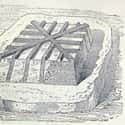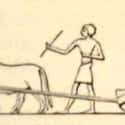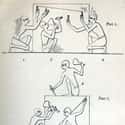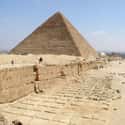
(#2) Workers Dug Around Granite And Pushed It Out Horizontally Rather Than Lifting It Vertically
The quarries used to mine granite for the pyramids brimmed with natural "obelisks" of rock that should have been impossible to remove from the ground with ancient technology. Instead, Egyptian workers simply removed the ground itself.
After identifying granite obelisks and chipping away at the weathered upper layers, workers dug deep trenches all around the obelisk to undercut the rock and free it from the earth. Then, they cleared a path on one side so that it could be pushed out horizontally instead of lifted out vertically - a decidedly easier task.
Much of the evidence for these techniques comes from a famed "Unfinished Obelisk" that became abandoned midway through extraction.
(#11) Scientists Disagree About The Design Of Ramps Used To Lift Blocks
Workers implemented ramps to pull granite blocks out of ancient Egyptians quarries, and most Egyptologists agree the ramps likely helped elevate the blocks into place once they reached the construction site of the pyramids. What they don't agree on, however, is the design of said ramps.
There are numerous proposed models of these ramps, each with a set of pros and cons, ranging from simple to uncharacteristically complex. Little evidence has turned up to point researchers in any particular direction to solve this mystery.
(#7) Rudimentary Sledges Helped Drag Material Across The Egyptian Desert
Once the granite blocks were out of the quarries, they still had to be transported across miles of desert to reach the great construction sites of Giza. Dragging tons of stone across the desert would seem a Herculean task for an ancient civilization, but the Egyptians conquered this conundrum with little more than toboggans.
Plenty of evidence has emerged of rudimentary sleds used by ancient Egyptians to haul massive materials across the sands of the Sahara. They were usually little more than flat surfaces with upturned edges, designed to glide over the dunes like a sleigh across the snow.
The substantial weight of the pyramids' granite blocks complicated the process - because heavily burdened sleds would dig into the sand - but ancient Egyptians had a solution for that, too: water.

(#10) Lighter Blocks Were Floated From Canals To The Nile
An Egyptian official's papyrus diary recently uncovered by archaeologists references a series of canals connected to the Nile. These canals were used to float blocks of up to 15 tons to Giza, though heavier stones still needed to be hauled across the land.
According to the diary, wooden boats lashed together with ropes assisted in ferrying granite and limestone from Tura to Giza. The canals were functional only during the summer season when the Nile had flooded.
Their design was sophisticated enough to allow for the creation of artificial ports, including one conveniently close to the pyramid worksites.
(#3) The Egyptians Used An Ingenious Technique To Cut Granite Into Blocks
Quarrying the rock-hard granite out of the earth and cutting it to shape is a difficult process even in the modern era, so archaeologists have long wondered how the ancient Egyptians managed to pull it off. The most compelling theories - backed by physical evidence - point to an ingenious method in which workers punched a series of holes in the rock with iron chisels, then stuffed those holes with wooden wedges.
The wedges were drenched with water, making them expand until they split the rock. Then, the Egyptians went to work on those fissures with their chisels until the granite got cut into a block.
(#14) Simple Machines Might Have Avoided The Long-Theorized Need For Dubious Sources Of Labor
Popular convention has long held that the sheer labor of hundreds of thousands of enslaved persons went into building the pyramids. This myth goes as far back as the histories of Herodotus, but modern archaeological discoveries turn the notion on its head. Evidence from the mud-brick tombs of the workers who built the pyramids suggests the builders were smaller in number and of a higher social status than previously believed.
According to researchers, the total number of builders was probably around 10,000, a significantly smaller amount than the hundreds of thousands previously reported. Combined with the archaeological evidence of several simple machines used in the extraction and transportation of granite, this new information paints a clear picture of ancient Egyptians using basic technology and ingenuity - not captives - to construct the pyramids.
New Random Displays Display All By Ranking
About This Tool
The Egyptian pyramids are the tombs of Pharaoh, the ruler of ancient Egypt more than 4,500 years ago. The ancient Egyptians believed that life is a short stay, and can only be enjoyed forever after death. Therefore, the pharaoh would spend decades building his pyramid. Facing these giant tombs of tens of meters or even hundreds of meters, archaeologists tried to obtain more information to understand why the ancient Egyptians had such superb construction skills thousands of years ago.
Pharaoh Khufu’s Pyramid is the largest. There is no cement, but it is built of stones. The average weight of the stones used to build the pyramid is 2.5 tons, and it is still difficult to insert a sharp blade into the gap between the stones. The unsolved mysteries about the Egyptian pyramids are also creepy. The random tool shows 14 details about how ancient Egyptians transported blocks to build pyramids.
Our data comes from Ranker, If you want to participate in the ranking of items displayed on this page, please click here.














